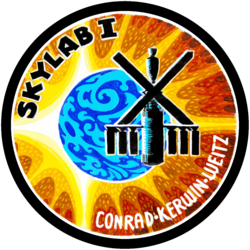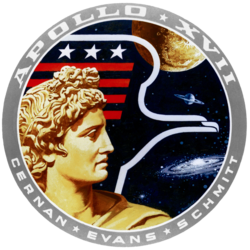Skylab 2
| Skylab 2 | |||
 | |||
| Statistik för uppdraget | |||
|---|---|---|---|
| Uppdrag | Skylab I | ||
| NSSDC-ID | 1973-032A[1] | ||
| Anrop | Skylab 2 | ||
| Varaktighet | 28 dagar, 49 minuter, 49 sekunder | ||
| Uppskjutning | |||
| Raket | Saturn IB | ||
| Uppskjutningsramp | Kennedy Space Center LC 39B Florida | ||
| Uppskjutning | 25 maj 1973, 13:00:00 UTC | ||
| Landning | |||
| Landning | 22 juni 1973, 13:49:48 UTC | ||
| Landningsplats | 24°45′N 127°2′V / 24.750°N 127.033°V | ||
| Omloppsbana | |||
| Varv runt jorden | 404 st | ||
| Distans | 18 500 000 km | ||
| Dockning | |||
| Dockning | 26 maj 1973, 09:56 UTC | ||
| Port | fram | ||
| Ur dockning | 26 maj 1973, 10:45 UTC | ||
| Andra dockningen | 26 maj 1973, 15:50 UTC | ||
| Port | fram | ||
| Andra ur dockning | 22 juni 1973, 08:58 UTC | ||
| Tid dockad | 26 dagar, 11 timmar, 51 minuter | ||
| Rymdpromenad | |||
| Antal rymdpromenader | 3 st | ||
| Total tid för rymdpromenad | 5 timmar, 41 minuter | ||
| Besättning | |||
| Besättning | Pete Conrad (4) Paul Weitz (1) Joseph Kerwin (1) | ||
 V-H: Kerwin, Conrad, Weitz | |||
| Kronologi | |||
| |||
Skylab 2 eller SL-2 var den första besättningen som ankom till den amerikanska rymdstationen Skylab. Farkosten sköts upp med en Saturn IB-raket från Kennedy Space Center LC 39B den 25 maj 1973.
Man dockade med rymdstationen den 26 maj 1973.
Efter 26 dagar ombord lämnade man rymdstationen den 22 juni 1973. Några timmar senare återinträdde man i jordens atmosfär och landade i Stilla havet.
Besättningen bestod av astronauterna Pete Conrad, Paul Weitz och Joseph Kerwin.
Under flygningen aktiverade man rymdstationen och reparerade några av de skador som uppstod på rymdstationen då den sköts upp.
Se även
Källor
Fotnoter
- ^ ”NASA Space Science Data Coordinated Archive” (på engelska). NASA. https://nssdc.gsfc.nasa.gov/nmc/spacecraft/display.action?id=1973-032A. Läst 27 mars 2020.
| |||||||||||||||||||||||
| |||||||||||||||||||||||||||||||||
Media som används på denna webbplats
This is the emblem for the second manned Skylab mission. It will be a mission of up to 56 days. The patch symbolizes the main objectives of the flight. The central figure, adapted from Leonardo da Vinci's Vitruvian Man, illustrates the proportions of the human form and suggests the many studies of man himself to be conducted in the zero-gravity environment of space. This drawing is superimposed on two hemispheres representing the two additional main areas of research - studies of the Sun and the development of techniques for survey of the Earth's resources. The left hemisphere show the Sun as it will be seen in the red light radiated by hydrogen atoms in the solar atmosphere. The right hemisphere is intended to suggest the studies of Earth resources to be conducted on Skylab. Although the patch denotes this mission as Skylab II, it is actually consided to be the Skylab III mission. Image ID: S72-51123
Författare/Upphovsman: Pascal (Flickr user: pasukaru76), Licens: CC0
Vostok spacecraft replica at the Technik Museum Speyer, Germany.
This is the emblem for the first manned Skylab mission. It will be a mission of up to 28 days. Skylab is an experimental space station consisting of a 100-ton laboratory complex in which medical, scientific and technological experiments will be performed in Earth orbit. The prime crew of this mission will be astronaut Charles Conrad Jr., commander; scientist-astronaut Joseph P. Kerwin, science pilot; and astronaut Paul J. Weits, pilot. The patch, designed by artist Kelly Freas, shows the Skylab silhouetted against the Earth's globe, which in turn is eclipsing the sun--showing the brilliant signet-ring pattern of the instant before the total eclipse.
This is the official emblem of the Apollo 17 lunar landing mission which was flown by astronauts Eugene A. Cernan, Ronald E. Evans and Harrison H. Schmitt.
- The insignia is dominated by the image of Apollo, the Greek sun god. Suspended in space behind the head of Apollo is an American eagle of contemporary design, the red bars of the eagle's wing represent the bars in the United States flag; the three white stars symbolize the three astronaut crewmen. The background is deep blue space and within it are the moon, the planet Saturn and a spiral galaxy or nebula. The moon is partially overlaid by the eagle's wing suggesting that this is a celestial body that man has visited and in that sense conquered. The thrust of the eagle and the gaze of Apollo to the right and toward Saturn and the galaxy is meant to imply that man's goals in space will someday include the planets and perhaps the stars. The colors of the emblem are red, white and blue, the colors of our flag; with the addition of gold, to symbolize the golden age of space flight that will begin with this Apollo 17 lunar landing. The Apollo image used in this emblem was the famous Apollo of Belvedere sculpture now in the Vatican Gallery in Rome. This emblem was designed by artist Robert T. McCall in collaboration with the astronauts.
Skylab General Mission-Patch
S73-24303 (May 1973) --- These three astronauts have been named by the National Aeronautics and Space Administration as the prime crew of the first manned Skylab mission. They are, left to right, Joseph P. Kerwin, science pilot; Charles Conrad Jr., commander; and Paul J. Weitz, pilot. Skylab is a three-part program consisting of one 28-day and two 56-day manned visits spanning an eight-month period. One day prior to the launch of this crew, the unmanned Skylab space station cluster will be launched and placed in Earth orbit. The first manned mission will last up to 28 days.










